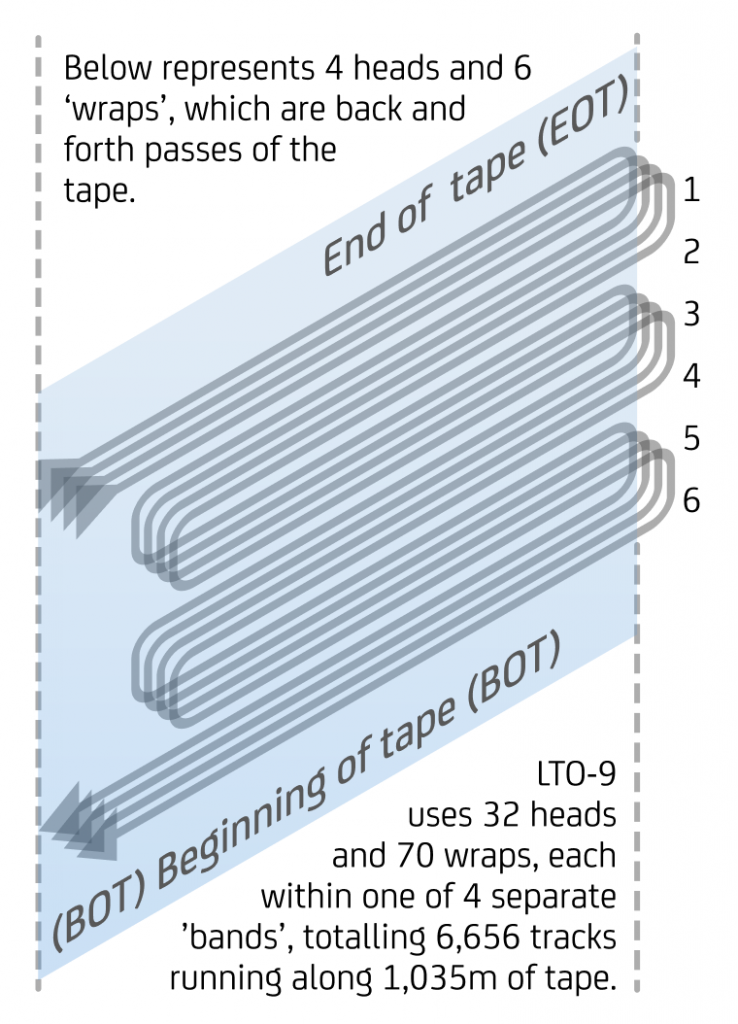For many, the idea of writing data to a tape seems simple. Start at the beginning and continue to the end, much like an old C90 cassette tape or VHS recording. However, modern Linear Tape-Open (LTO) technology works in a completely different way. Understanding how LTO writes and organizes data is not just an interesting deep dive into storage technology, but also helps to explain key processes like tape initialization and how servo tracks keep everything aligned. If you’re using LTO tape for long-term data archiving, this article will give you a new appreciation for the technology keeping your data safe.
Not a Straight Line: How LTO Actually Writes Data
Instead of writing data in a simple, linear manner from the beginning of the tape (BOT) to the end (EOT), LTO tapes use a method called serpentine recording. This means that data is written in multiple parallel tracks across the tape’s width, moving back and forth as it progresses along the length of the tape.

Each LTO tape is divided into data bands (DBs)—regions that hold data—and servo bands (SBs), which contain pre-written positioning information. The tape head moves laterally across these bands as data is written, following a structured pattern to maximize storage density and ensure reliability.
When a new tape is used, writing begins in one of the data bands. A single pass writes multiple tracks at the same time, then at the end of the tape, the head shifts slightly, and the next set of tracks is written in the opposite direction. This process repeats, zigzagging back and forth until the entire tape is filled.
This shingled recording technique increases storage density while maintaining compatibility with previous generations of LTO. In LTO-9, for example, 32 tracks are written in parallel at a time, and the tape contains 280 total wraps. This enables massive storage capacity while maintaining efficient data retrieval.
The Role of Servo Tracks: Keeping Data Aligned
Since tape is a physical medium, precise positioning of the read/write head is crucial. Unlike hard drives, which have rigid platters, LTO tape is flexible and can stretch, warp or shift slightly during operation. To ensure accurate reading and writing, servo tracks are pre-recorded onto the tape during manufacturing. These tracks serve as guides, helping the tape drive align the read/write heads with microscopic accuracy.
LTO tapes have five servo bands running the full length of the tape, dividing the data bands into four sections. The servo tracks contain a unique pattern of magnetic signals that the tape drive continuously reads to adjust the head’s position in real time. Without these guides, reading back data from a tape accurately would be nearly impossible, as even minor misalignments could cause errors.
Why Does LTO-9 Tape Require Media-Initialization?
If you’ve used an LTO-9 tape, you may have noticed that the first time you insert a new tape into a drive, it takes around one hour before you can start writing data. This is due to an important process called media-initialization.
LTO-9 introduced a major change: it shifted from linear servo tracks to a more advanced timing-based servo (TBS) system. Unlike earlier generations, where servo tracks were written in a straightforward manner, LTO-9 servo signals are encoded using precise timing patterns. This change improves tape tracking accuracy and allows for higher areal densities, but it also means each tape needs to be “prepared” before first use.
During media-initialization, the drive scans the tape and maps out the servo signals, ensuring they align perfectly with the drive’s internal calibration. This calibration process ensures that when data is written, it can be precisely located and retrieved later, minimizing errors. However, it is important to note that this process does not lock the tape to the specific drive in which it was initialized. Once media-initialization is completed in one drive, the tape can then be used in any compatible LTO-9 drive for reading and writing without the need for re-initialization.
While media-initialization takes time, it is a crucial step in guaranteeing the long-term reliability of the tape’s data and ensuring that all drives can interpret the servo signals correctly.
What This Means for Tape Users
Understanding how LTO tapes write data helps explain why they are so effective for long-term storage and why certain processes, like media-initialization, take time. The combination of serpentine recording, servo-assisted tracking, and the new TBS system makes LTO-9 a highly efficient and reliable archival solution.
For businesses using LTO tape alongside archival software, knowing these details can help optimize workflows. For instance:
- If you’re setting up a new batch of LTO-9 tapes, allocate time for media-initialization before starting large-scale backups.
- Be aware that writing to tape isn’t just a simple stream but a carefully organized process, one cannot know if a file is at the start, middle or end of the tape, based on when it was written. If the tape is damaged in one spot, many hundreds of files could be affected.
- Take advantage of tape’s low power consumption and offline security benefits by structuring your data archives effectively.
With LTO technology continuing to evolve, the way data is stored on tape will keep improving. But one thing remains constant: tape’s role as a high-capacity, cost-effective, and secure solution for long-term data retention.
Final Thoughts
LTO tape is far more advanced than many assume. Its unique approach to writing data, the role of servo tracks, and the necessary media-initialization process all contribute to why it remains a leading archival storage medium. By understanding these aspects, users can make the most of their LTO-based archiving solutions, ensuring reliability and efficiency for years to come.If you’re looking to optimize your tape-based archiving setup, Archiware P5 is designed to seamlessly integrate with LTO drives and libraries, handling all aspects of data backup and archive, while ensuring efficient access and long-term security.
